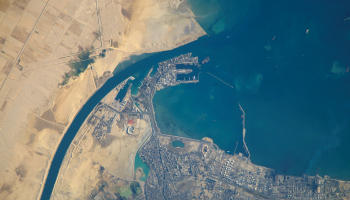The Missing Kingdom: Why Fungi Must Be Central to Conservation Strategy
28 December 2025
Published online 6 August 2015
As the expanded Suez Canal is inaugurated today with much fanfare, biologists warn of a mass migration of Red Sea fish into the Mediterranean’s fragile ecosystem.

© NASA
For about 80 years after the canal was built, the high salinity in the Bitter Lakes and Lake Timsah, combined with the flow of freshwater from the Nile river into the Mediterranean prevented Red Sea species from invading – the difference in salinity between the bitter and fresh waters forming a natural barrier. With the building of the high dam, the mouth of the delta was flooded with fresh water, eroding the natural barricade.
Red Sea species live in one of the most stressful marine environments with water salinity reaching 39ppt, compared to the Mediterranean's 30ppt, and the water is warming faster than anywhere on the planet, according to a 2011 KAUST study1.
These highly stressful conditions and fierce competition among species for food resources have led to extraordinary adaptation capacities in Red Sea species, making them formidable competitors for their Mediterranean counterparts.
Some successful invaders have outcompeted indigenous species for resources in certain areas, displacing them from their natural habitat. The most robust of them have spread through the entire Mediterranean, dramatically altering the sea’s ecological balance.
Although figures vary, marine experts generally agree that about 90 Red Sea fishes have successfully invaded and adapted to the Mediterranean habitat, competing with roughly 500 indigenous reef fish species.
Two species of Rabbitfish from the Red Sea, Siganus luridus and Siganus rivulatus have altered the entire base of the food chain in the Eastern Mediterranean over a very short period, causing the once well-developed native algal assemblages in the Levantine rocky littoral to become barren.
Giacomo Bernardi, a professor of ecology and evolutionary biology at the University of California Santa Cruz, explains that the rabbitfish devoured all the algae, displacing two native herbivorous fish, the bream and the parrotfish, in addition to urchins, which feed on plants.
“In some locations you can no longer find either of those Mediterranean's indigenous species,” explains Bernardi.
The expansion creates one of the most potent corridors of invasion by marine species in the world.
Of almost 700 multicellular non-indigenous species currently recognized from the Mediterranean, half were introduced through the Suez Canal, wrote Bella S. Galil from the National Institute of Oceanography in Haifa and 17 co-authors in Biological Invasions academic journal in April 2015. In their paper2, “Double trouble”, the marine scientists express concern about the consequences of enlarging of what they termed “one of the most potent corridors of invasion by marine species in the world.”
They predict dire consequences on the biological diversity and the ecosystem goods and services of the Mediterranean Sea.
Some of the migrants are “noxious, poisonous or venomous and pose clear threats to human health,” the experts wrote. The pufferfish, Lagocephalus sceleratus, for example, which has recently invaded the area between the Levant, Italy and Tunisia contains in its organs a strong paralytic neurotoxin which can cause reactions from vomiting to respiratory arrest, seizures, coma and death.
Since the Bitter Lakes no longer draw enough salt from the ground to stall the passage of sea creatures to the Mediterranean, other preventive methods have been considered by the Egyptian government. In an Environmental Impact Assessment (EIA) that has not been made public, the authorities considered the feasibility of establishing a “bubble curtain,” in which air is pumped into underwater pipes pierced with tiny holes to create a turbulence to deter fish.

© Ruth Michaelson
Fouda tells Nature Middle East that an electrified barrier had been ruled out "as this option only works in freshwater environments.”
He explains that the 276 million cubic meters of agriculture wastewater dumped annually into the Bitter Lakes have significantly diluted their salinity levels and rendered them inefficient as natural barriers. He says that the wastewater will be rerouted to other canals “very soon.”
But Chad Hewitt, one of the co-authors of “Double trouble” and a researcher on the ecology of human-mediated transfers of species at the University of Waikato in New Zealand, explains that the real issue is “whether you manage to create a salinity difference large enough between the two locations to procure a sufficient amount of stress to the migrating fish.”
Bernardi believes whichever method the government employs to thwart migrating fish, “the bottom line is that the canal has been widened and that more migrants will reach the Mediterranean.
“I think it is a waste of energy and money to try to do anything, because when you work in the ocean you know that it is a mess and that nothing works,” he says. “[But] if you have to change one factor, changing salinity is the best idea.”
doi:10.1038/nmiddleeast.2015.133
Stay connected: